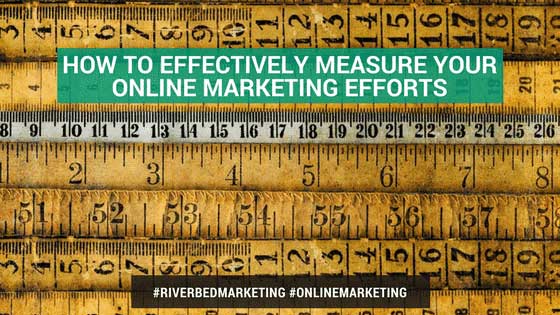Seth Godin once said: “What could you measure? What would that cost? How fast could you get the results? If you can afford it, try it. If you measure it, it will improve.”
Table of Contents
ToggleWhy Measure Marketing?
Measurement lies at the core of success management and therefore online marketing. Without marketing measurement you have no yardstick with which to compare to and improve against. And without that benchmark you will likely be left with the unsettling feeling of paralysis – well aware of the general marketing activities that could lead to success, but unable to take meaningful action in any one direction.
Essentially, measurement helps you build enough insight to make reasonable and rational conclusions and take action.
What Should You Be Measuring?
Depending on the products or service that your brand delivers measurement can take the shape of many forms. For example, a brick and mortar retail store might track at the customer service and sales level the total number of phone calls made (and where those consumers mentioned they found the business – as well as which converted to a sale) They might also want to track driving direction requests from their Google My Business account to understand how many consumers wanted directions to the business.
Conversely, an online SaaS (software as a service) platform which sells recurring subscriptions might want to track total traffic by channel and how much of that traffic converted to signing up for a guided demo of the product.
How To Create a Measurement Plan
A measurement plan is an organized plan designed to accurately measure important metrics in marketing that are critical to success for your business. These metrics are known as KPIs, or key performance indicators.
In order to drive meaningful and actionable changes in an organization specifically in marketing (but also in sales) it is very important to understand what to track and what is not important – sometimes known as a ‘vanity metric’
For risk of reinventing the wheel, I won’t go in depth here in how to build this plan for your organization. Avinash Kaushnik has taken a deep-dive into this process and breaks this down very well here.
What You Should Consider Tracking
Here are some common inbound marketing metrics we like to use to help measure marketing campaigns:
SEO
- Organic site traffic +/- (MOM and YOY)
Total traffic from organic search engines measured month over month and year over year for the business.
- Unique new organic visitors versus returning visitors
The total number of new visitors vs. returning visitors from organic search only.
- Time on site (organic only)
The total average time on site that visitors from organic search engines spend. This should be further segmented to specific pages in order to gain more actionable insight.
- Page views per visit (organic only)
The average total number of pages your visitors view when on your website.
- Bounce rate by page (organic only)
Total bounce rate for visitors from organic search engines only, by page.
- Conversion rate to Goals (organic only)
Total conversion rate, expressed as a percentage for organic search engine visitors reaching goals.
- Total revenue (organic only, last month)
Total revenue from organic traffic online, expressed month over month and year over year.
- Average order size (organic only, MOM, YOY)
Average order size from organic traffic online, expressed month over month and year over year.
PPC (Account-Specific)
- Average Cost Per Click (MOM and YOY)
Average cost per click for relevant keywords in your paid search account (i.e. Google, Bing).
- Average Quality Score (MOM, YOY)
Average quality score for keywords within the account.
- Click Through Rates
CTR, or click through rate by Ad or by keyword at any given time in the account.
- Page views per visit (paid search only)
The total number of pages paid search traffic visit once they click your ad.
- Bounce rate by page (paid search only)
The average bounce rate, by page, for visitors who arrived after clicking your paid ad. Bounce Rate is the percentage of single-page sessions (i.e. sessions in which the person left your site from the entrance page without interacting with the page).
PPC (Non Account-Specific)
- Paid Search traffic +/- (MOM and YOY)
Total paid search traffic comparison month over month and year over year.
- Paid traffic new visitors versus returning visitors
Total new traffic from paid search versus visitors who returned after initially visiting the website from paid search.
- Time on site (paid search only)
The total time on the website that paid search visitors spend, on average.
- Conversion rate (paid search only, by goal)
Conversion rate to goal from paid search traffic.
- CPA or CPL (paid search only, MOM and YOY)
Total cost per acquisition and cost per lead, depending on your business type, expressed month by month and year over year.
- ROAS (Return on Ad Spend) (paid search only, MOM and YOY)
Return on ad spend, expressed as a percentage of account spend versus gross revenue from product or service sales.
- Total sales (paid search only, MOM or YOY)
Total sales generated from paid search only.
- Average order size (paid search only, MOM and YOY)
Total unique traffic to website / property (by SM channel, MOM and YOY).
Social Media
- Total unique traffic to website/property (by SM channel, MOM and YOY)
Total traffic from social media which was directed to your website, month over month and year over year.
- Total fans and followers (MOM and YOY)
Total increase or reduction in fans and followers in your social media business pages.
- Total brand mentions (MOM and YOY)
Total number of brand mentions across social media month over month and year over year.
- Total website conversions (social media only, MOM and YOY)
Total Goal conversions from social media traffic, month over month and year over year, by social media platform.
Direct Traffic
- Direct site traffic +/- (MOM and YOY)
Total direct traffic to the website month over month and year over year.
- Unique new direct traffic vs returning direct traffic
New versus returning direct traffic.
- Time on site (direct only)
Total time on site direct traffic spent, preferably segmented down the page level.
- Page views per visit (direct only)
Total number of pages viewed, on average per visit from a direct visitor.
- Bounce rate by page (direct only)
Total bounce rate by page for direct traffic.
- Conversion rate to Goal (direct only)
Conversion rate to Goal from direct traffic.
- Total revenue (direct only, MOM or YOY)
Total revenue from direct traffic month over month and year over year.
- Average order size (d only, MOM, YOY)
Average order size from direct traffic.
Content Marketing (On Site Content)
- Total traffic, by piece, by source (MOM and YOY)
Total traffic to a piece of published content by source, month over month and year over year.
- Total Downloads (for downloadable content) (MOM and YOY)
Total number of downloadable content pieces, by piece, month over month and year over year.
- Time on Page
Total time visitors spend on the page.
- Total inbound links acquired (by content piece)
Total number of inbound links acquired to the specific piece.
- Total shares, likes (by content piece)
Total number of shares of the particular piece of content in social media platforms, by content piece (and preferably segmented down to each social media platform).
- Total conversions by page (MOM and YOY)
Total goal conversions by page (depending on specific goals defined and offers)
Content Marketing (Off Site Content)
- Total traffic to website (from content, MOM and YOY)
Total traffic to brand from marketed content month over month and year over year.
- Total Downloads (for downloadable content) (MOM and YOY)
Total download of offline content month over month and year over year.
- Total Average inbound links acquired (by content piece)
Total inbound links pointing at each marketed piece of content.
- Total shares, likes (by content piece)
Total shares of offsite content, by social media platform.
- Total inbound links acquired (by content piece)
Total number of inbound links acquired to the specific piece.
In the end, measurement of campaigns is everything, and often baby steps are required in order to get there – especially if you are consistently testing new inbound marketing activities.
Are you measuring marketing campaigns in additional exciting and innovative ways? Share with us, or ask questions in our comments section below.












